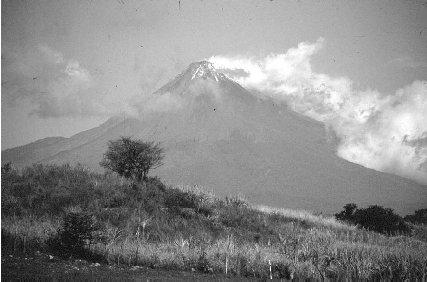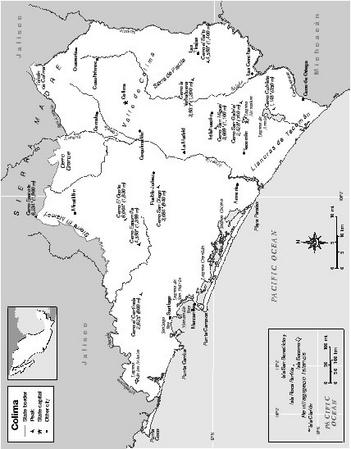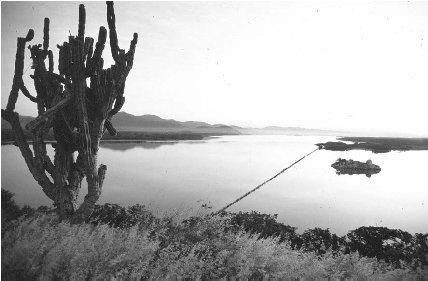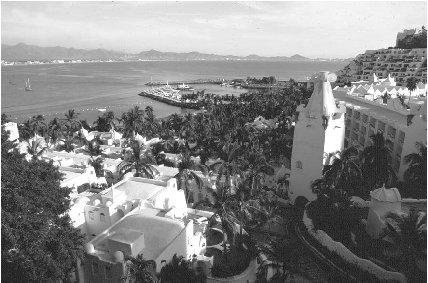Colima

Pronunciation: koh-LEE-mah.
Origin of state name: From the Náhuatl (Amerindian) word collimaitl. Colli means either ancestors or volcano, and maitl means domain of.
Capital: Colima.
Entered country: 1857.
Coat of Arms: The coat of arms bears a hieroglyph (a picture with special meaning) in the form of an arm. For the state's early inhabitants (Náhuatl), the arm represented the power of one person over all others. This authority essentially fell to the elders, who were greatly respected and obeyed. The coat of arms therefore symbolizes the strength of the people of Colima to improve their living conditions.
Holidays: Año Nuevo (New Year's Day—January 1); Día de la Constitución (Constitution Day—February 5); Benito Juárez's birthday (March 21); Primero de Mayo (Labor Day—May 1); Revolution Day, 1910 (November 20); and Navidad (Christmas—December 25).
Flag: There is no official flag.
Time: 6 AM = noon Greenwich Mean Time (GMT).
1 Location and Size
Colima lies in western Mexico. It is bordered on the north, east, and west by the Mexican state of Jalisco; on the southeast by the Mexican state of Michoacán; and on the south by the Pacific Ocean. Its capital city is Colima. The state has an area of 5,433 square kilometers (2,098 square miles), which is about the same size as the US state of Delaware. It is one of the smallest states in Mexico. (The only smaller states are Aguascalientes, Morelos, Tlaxcala, and the Distrito Federal—Federal District). Colima has ten municipalities.
Colima's landscape consists of mountains, hills, valleys, plains, and deep ravines. A branch of the Sierra Madre mountain range runs through the state. The highest peak in the state is the Colima Volcano at 4,240 meters (13,990 feet), the country's most active volcano. It lies on the border with Jalisco and has erupted over forty times since the 1500s. Damaging earthquakes, the most recent in 2003, are relatively frequent.
Colima's rivers flow from north to south into the Pacific Ocean. Major rivers include the Marabasco River and the Coahuayana (or the Naranjo) River. The Armería River, the largest of all, originates in Jalisco

The highest peak in the state is the Colima Volcano at 4,240 meters (13,990 feet), the country's most active volcano. It lies on the border with Jalisco and has erupted over forty times since the 1500s.
Colima has 160 kilometers (100 miles) of coastline. The Cuyutlán Lagoon is a large saltwater lagoon on the Pacific coast. It is used for salt production. The Manzanillo and Santiago Bays are both on the Pacific coastline.
The state includes the Revillagigedo Archipelago in the Pacific. It also includes Roca Partida, San Benedicto, Clarión, and Socorro islands.
2 Climate
Temperatures are fairly constant year round, with variation depending on elevation. In the winter, temperatures range from 20° c to 28° c (68° f to 76° f ). Summers are hotter, with temperatures ranging from 28° c to 34° c (82° f to 93° f ). The rainy season falls from June through October, when much of the average annual rain falls. Rainfall during those months averages 1,010 millimeters (40 inches).
3 Plants and Animals
Colima is one of the richest Mexican regions in species and one of the top

4 Environmental Protection
In 2003, Colima received a federal grant to establish a system requiring industries to track pollutants. Sierra de Manantlan Biosphere Reserve straddles the border with Jalisco. Over 2,700 species of plants, 40% of which are native to Mexico, are protected there. About one-fourth of Mexico's species of mammals and one-third of its bird species find habitat in the reserve.
5 Population, Ethnic Groups, Languages
Colima had a total population of 542,627 in 2000; of the total, 268,192 (49%) were men and 274,435 (51%) were women. The population density was 96 people per square kilometer (249 people per square mile). In 2000, the capital, Colima, had a population of 129,454. Almost all the residents speak Spanish, with less than 1% speaking one of the Amerindian languages.
6 Religions
According to the 2000 census, 78% of the population, or 425,954 people, were Roman Catholic; just 2%, or 13,214 people, were Protestant. That year there were also 5,185 Jehovah's Witnesses, and nearly 12,000 people who reported no religion.
7 Transportation
There are 1,960 kilometers (1,225 miles) of highway connecting the state's ten cities. Eight of the ten municipalities have four-lane highways.
The Playa del Oro International Airport serves Manzanillo and the Miguel de la Madrid Airport is near the capital, Colima. Both provide domestic and international air service.
Manzanillo on the Pacific Ocean is Mexico's main deep-sea port. The port is equipped to unload large containers from ships and move them around on 13.5 kilometers (8.4 miles) of railway track. Agricultural grains and cement are among the many products shipped through Manzanillo's port. Manzanillo provides Mexico with shipping routes to the nations of Asia (Japan, South Korea, China, Indonesia, Australia, and New Zealand). It also provides shipping to other nations in the Americas, including Canada, the United States, Guatemala, Costa Rica, Colombia, and Peru.
There is no passenger train service in Colima, but 235 kilometers (147 miles) of railroad track transports cargo from the port and other Colima cities to other locations in Mexico.
8 History
The first human settlements date back to 300 A . D . Early civilizations, such as the Toltec (around 900) and the Chichimec (around 1100), were the first to build cities and introduce productive agriculture to the region. Colimán, an indigenous leader who ruled in the 15th century, converted Colima into a political, cultural, and military center of Mexico before the arrival on Europeans.
The Spanish tried three times in the early 1500s to colonize Colima but met with fierce resistance from the native population. Finally, Spaniard Gonzalo de Sandoval conquered the region and built a Spanish settlement, San Sebastián de Colina, in 1523. Later,

The Cuyutlán Lagoon is a large saltwater lagoon on the Pacific coast. It is used for salt production.
When the independence movement broke out in 1810, Colima priest José Antonio Díaz led independence fighters who wanted to follow Miguel Hidalgo and his drive for Mexican independence from Spain. Hidalgo had previously lived and worked as a priest in Colima. Spanish royalists (followers of the king) successfully prevented the independence fighters from gaining control of Colima. The independence struggle continued throughout the decade. Finally in 1821, the royalist forces accepted independence and signed the Plan of Iguala agreement that secured Mexico's independence from Spain.
In 1823, Colima was incorporated into the state of Jalisco. After a short period as a federal territory and as a territory of Michoacán , Colima was declared a state of the Mexican federation in 1857. For a brief period of three months, Colima was the federal capital, under the presidency of Benito Juárez (1806–1872). In November 1864, French troops occupied Colima and incorporated it into the lands effectively ruled by Mexican emperor Maximilian (1832–1867). After Maximilian's defeat, Juárez and, more importantly, Mexican general and politician Porfirio Díaz (1830–1915) received the support of the leaders in Colima. During Porfirio Díaz's presidency (from 1877 to 1880 and then again from 1884 to 1911), economic development favored Colima. A new railroad and important infrastructure investments helped expand agriculture and other economic activities.
In 1910 the Mexican Revolution began. It reached Colima in 1911, when the governor surrendered to the revolutionary forces. After the passage of the Mexican Constitution in 1917, Colima passed its own constitution later that year. The new governor, loyal to the revolutionary victors, assumed power shortly after. However, some political instability remained. Factions loyal to former revolutionary and antirevolutionary leaders continued to operate in Colima. Eventually, in 1943, stability was finally achieved and governors were able to complete their six-year terms without much opposition. The consolidation of Institutional Revolutionary Party (PRI, the most powerful political party in Mexico) rule also reached Colima. PRI candidates successfully won the gubernatorial races without much opposition from the conservative National Action Party (PAN) in the 1950s, 1960s, and 1970s, or the leftist Party of the Democratic Revolution (PRD) starting in the late 1980s.
The PRI candidate Gustavo Alberto Vázquez Montes was elected governor in 2003. He defeated the candidate of the joint PAN-PRD opposition.
9 State and Local Government
With formal separation of powers and check-and-balances provisions, the state of Colima has a unicameral (one chamber) state congress and a strong executive power. The congress is elected every three years for nonrenewable terms. Sixteen of its twenty-five members are elected in single member districts; nine are elected by proportional representation. Because the PRI has exercised control of the powerful governor's office since the end of the revolution, the legislature has not been able to act independently. As politics become more competitive in Colima, the legislature should be more likely to act independently of the governor.
There are ten municipalities, each with a local government. These local governments have limited authority over administrative decisions. Tight control of budgets by the state government reduces the local authorities' leverage and influence. Municipal president and council members are elected for nonrenewable three-year terms.
10 Political Parties
The three main political parties in all of Mexico are the Institutional Revolutionary Party (PRI), the National Action Party (PAN), and Party of the Democratic Revolution (PRD). The PRI has dominated Colima politics since the end of the Mexican Revolution (1910–1920). All Colima governors have belonged to that party. Despite more guarantees for opposition parties and free and fair elections since the early 1990s, the PRI continues to dominate politics in the state. A joint PAN-PRD effort to win the gubernatorial race in 2003 failed. The PRI candidate successfully defeated the opposition consensus candidate.
11 Judicial System
The highest court in Colima is the Superior Tribunal of Justice. Its members are appointed for nonrenewable six-year terms by the governor with congressional approval. Only qualified attorneys can be appointed to those posts. In addition, an electoral tribunal and several different local courts make up the judiciary in Colima. Yet, as is the case with the other state level powers, the dominance enjoyed by the PRI throughout most of the 20th century has made it difficult for any branch of government to function independently.
12 Economy
The manufacture of iron, services, tourism, agriculture and agricultural product processing, mining, and fishing are the components of the economy in Colima. As of 2000, the economy was growing at about 5% annually. The per capita gross state product was p56,364 (p = pesos) per year, or just over us$5,000 per person.
13 Industry
Colima ranks first among Mexico's states in the production of lemon oil and second in the production of iron. Iron ore is processed at Lázaro Cardenas. Other important industries include the manufacture of beverages (including dairy products), metal structures, food preservatives, and wooden furniture. There are also facilities where grains are processed into cereals. Colima also is home to a number of printers and publishing companies.
Tecomán, near the coast in the center of the state, is the main center where cement is produced. Also near Tecomán is one of the world's largest facilities where pectin is produced. Pectin is used to make jellies, among other things. The pectin is produced for export to the United States, Europe, and Asia.
14 Labor
The US Bureau of Labor Statistics reported that Mexican workers saw their wages increase 17%, from $2.09 per hour in 1999 to $2.46 per hour in 2000. (The average US worker earned $19.86 per hour in 2000.) After one year, workers are entitled by law to six days paid vacation.
From 1999 to 2000, formal employment increased by 4,331 jobs. Unemployment stood at 1.9% in the cities of Colima and Villa de Alvarez , and less than 1% in the port city of Manzanillo.
15 Agriculture
Colima is Mexico's largest producer of sour lemons, tamarind (long, brown pod with sweet/sour pulp), and guanabana (deep green fruit covered with small, soft spines). It is the country's second-largest producer of coconuts. Among the agricultural products are candies produced from coconuts.
Also produced in Colima are fruits including the Mexican lemon (limón), melons, mangoes, papaya, watermelon, yellow seedless watermelons, and bananas. Other crops include corn, sugar cane, jalapeño chiles, cherry tomatoes, and cucumbers.
Palms are also cultivated for use in landscaping, and palm fibers are used to weave hats, placemats, floor mats, and other items.

The city of Manzanillo lies on the Pacific coast.
16 Natural Resources
The Pacific Ocean waters are rich with marine life. There is commercial fishing for tuna, giant squid, and shark, with processing plants located near the port of Manzanillo. Colima ranks second among all the states in tuna production. Sport fishing is also popular.
17 Energy and Power
Electricity for the entire state is produced by two coal-burning power plants in Manzanillo. The plants also sell the surplus power (as much as 95% of the electricity produced) to other Mexican states and to other countries in the region.
18 Health
The state of Colima has 10 general hospitals, 153 outpatient centers, and 16 surgical centers throughout the state.
Most of the Mexican population is covered under a government health plan. The IMSS (Instituto Mexicano de Seguro Social) covers the general population. The ISSSTE (Instituto de Seguridad y Servicios Sociales de Trabajadores del Estado) covers state workers.
19 Housing
Housing styles vary widely. As of 2000, over 70% of Colima's housing stock was considered in good repair, with no problems requiring upgrading. A small percentage (8%) of the housing was categorized as needing "replacement or significant upgrading." In cities, many houses are stucco, often featuring large cracks, evidence of earthquake activity. In the small villages, housing may be constructed from cement blocks or twigs and corrugated iron.
20 Education
The system of public education was first started by President Benito Juárez in 1867. Public education is free for all students from ages six to sixteen. There were about 115,000 school-age children in the state in 2000. Many students elect to go to private schools. Families who can afford it send their children to private schools, while the poor often attend public schools with few materials.
The Universidad de Colima (University of Colima) and the Technological Institute of Colima are both located in the capital. The Monterrey Institute of Technology and Higher Education, the main campus of which is in Monterrey, Nuevo León, has a branch campus in Colima.
21 Arts
The state of Colima has over twenty theaters, many of them open-air style. One of the best known is the Teatro Hidalgo. Most major cities sponsor exhibitions and cultural fairs.
22 Libraries and Museums
Colima has 49 branches of the national library system. It also has 19 museums including the salt museum in the city of Armería. In the capital, Colima, are the Museo Regional de Historia (Museum of Regional History), the Museo de Artes Populares (Folk Art Museum), and the Museo de las Culturas de Occidente (Museum of Western Culture).
23 Media
In the capital of Colima, the newspaper Diario de Colima (Diary of Colima) is published. Internet service and cable television are available in Manzanillo and the city of Colima.
24 Tourism, Travel, and Recreation
The city of Colima is located at the base of an active volcano, the Volcan de Fuego. The Museo Regional de Historia (Museum of Regional History) houses displays of pre-Hispanic civilizations. The nearby village of Suchitlán is famous for its maskmakers. Manzanillo is known for its beautiful beaches. Sportfishing is popular: every February Manzanillo hosts the International Sailfish Tournament.
Beaches line the nearly 160 kilometer (100 mile) Pacific coast. Some beaches are covered with pebbles, while others have powdery white or black volcanic sand.
A favorite souvenir is the Colima dog, a replica of a ceramic dog figurine dating from the 1500s when Amerindian cultures flourished in the region.
25 Sports
Colima has a professional basketball team known as the Tuberos.
26 Famous People
José Antonio Díaz led the drive for independence starting in 1810. Vázquez Montes (b.1962) was elected governor in 2003.
27 Bibliography
Books
DeAngelis, Gina. Mexico. Mankato, MN: Blue Earth Books, 2003.
Supples, Kevin. Mexico. Washington, DC: National Geographic Society, 2002.
Web Sites
Mexico for Kids. http://www.elbalero.gob.mx/index_kids.html (accessed on June 15, 2004).
thank u so much